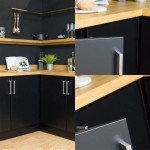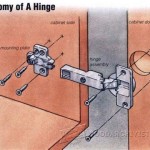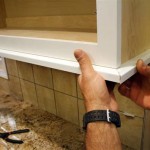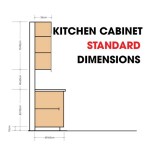Lazy Susan Turntable for Kitchen Cabinets: Maximizing Space and Accessibility
The lazy Susan turntable, a rotating tray placed within a kitchen cabinet, has long been recognized as an ingenious solution for optimizing storage and accessibility. This simple yet effective device transforms hard-to-reach corners and deep cabinets into organized and easily manageable spaces. The fundamental principle behind the lazy Susan turntable lies in its ability to rotate 360 degrees, allowing users to access items stored at the back of the cabinet without needing to reach, rearrange, or remove other items. This feature is particularly valuable in corner cabinets, where the depth and angled walls often make it difficult to retrieve stored contents.
The origins of the lazy Susan are shrouded in some mystery. Various claims exist regarding its invention and the person for whom it was named. Some attribute its invention to Thomas Jefferson for his daughter, Susan, while others point to the early 20th century, crediting various inventors and businesses. Regardless of its true origins, the lazy Susan has become a staple in kitchens worldwide, appreciated for its practicality and space-saving capabilities. Its application extends beyond kitchen cabinets, finding use in pantries, refrigerators, and even dining tables as a serving aid. The evolution of the lazy Susan has seen the introduction of various materials, sizes, and designs, catering to diverse needs and aesthetic preferences.
From a simple rotating platform made of wood to modern designs incorporating metal, plastic, and adjustable features, the lazy Susan turntable offers a wide range of solutions for organizing kitchen essentials. Its ease of installation and relatively low cost make it an attractive addition to any kitchen, contributing to a more efficient and organized cooking environment. This article will delve into the key benefits, different types, installation procedures, and factors to consider when selecting a lazy Susan turntable for kitchen cabinets.
Enhanced Accessibility and Organization
The primary function of a lazy Susan turntable is to improve accessibility to items stored deep within kitchen cabinets. Without a rotating mechanism, accessing items at the back of a cabinet often necessitates removing items in front, leading to disorganization and potential frustration. The lazy Susan eliminates this problem by allowing the user to simply rotate the platform, bringing the desired item to the front for easy retrieval. This is particularly beneficial for storing spices, canned goods, baking supplies, and other items that are frequently used but often relegated to the back of the cabinet due to their shape or size.
Furthermore, the lazy Susan turntable promotes better organization within the cabinet. By providing a designated space for frequently used items, it discourages clutter and encourages a more systematic approach to storage. Items are less likely to be misplaced or forgotten, as they are readily visible and accessible. This can lead to reduced food waste, as expired items are less likely to be overlooked. The circular design of the lazy Susan also allows for a more efficient use of space, particularly in corner cabinets where traditional shelving can leave awkward, unused areas.
Moreover, the rotating feature allows for better visibility of the stored contents. Instead of having to rummage through a cluttered cabinet, the user can quickly scan the rotating platform to locate the desired item. This not only saves time but also reduces the likelihood of purchasing duplicate items, as the available inventory is readily apparent. The enhanced visibility also makes it easier to restock items, as the user can quickly identify what needs to be replenished. This contributes to a more streamlined and efficient kitchen management system.
Types of Lazy Susan Turntables
Lazy Susan turntables are available in a variety of types, each designed to address specific storage needs and cabinet configurations. Understanding the different types is crucial for selecting the most appropriate option for a particular kitchen. The basic distinction lies in the shape of the turntable, with the most common types being full-circle, pie-cut, and D-shaped.
Full-circle lazy Susans are designed for standard rectangular cabinets. They provide a complete 360-degree rotation and are suitable for storing a wide range of items. Pie-cut lazy Susans, also known as kidney-shaped lazy Susans, are specifically designed for corner cabinets. Their shape allows them to fit neatly into the angled space, maximizing storage capacity. D-shaped lazy Susans are another option for corner cabinets, offering a similar space-saving design. These typically have a flat front edge that aligns with the cabinet door, providing a clean and integrated look.
Beyond the shape, lazy Susan turntables also vary in material and construction. Common materials include wood, plastic, and metal. Wooden lazy Susans offer a classic and aesthetically pleasing look, while plastic options are generally more durable and easier to clean. Metal lazy Susans are often used in heavy-duty applications, providing greater weight capacity and stability. Some lazy Susans feature multiple tiers, increasing storage capacity and allowing for better organization of items of varying sizes. Adjustable shelves are also available, providing even greater flexibility in organizing cabinet contents.
Another important consideration is the type of bearing mechanism. Some lazy Susans use simple friction-based rotation, while others employ ball bearings for smoother and quieter operation. Ball bearing mechanisms are generally preferred for heavier loads and more frequent use, as they provide greater stability and longevity. The choice of bearing mechanism will depend on the intended use and the desired level of performance.
Installation and Selection Considerations
The installation of a lazy Susan turntable is generally a straightforward process that can be completed with basic tools. However, it is important to carefully consider the dimensions of the cabinet and the turntable to ensure a proper fit. Before purchasing a lazy Susan, it is crucial to measure the internal dimensions of the cabinet, including the width, depth, and height. The diameter of the turntable should be slightly smaller than the internal width of the cabinet to allow for free rotation.
The installation process typically involves attaching the turntable to the base of the cabinet using screws or adhesive. Some models may require additional hardware, such as mounting brackets or support posts. It is important to follow the manufacturer's instructions carefully to ensure a secure and stable installation. For corner cabinets, it may be necessary to remove the existing shelving to create a clear space for the lazy Susan. In some cases, professional installation may be recommended, particularly for complex installations or for individuals who are not comfortable with DIY projects.
When selecting a lazy Susan turntable, several factors should be taken into consideration. The size and shape of the cabinet are primary determinants, as the turntable must fit properly within the available space. The intended use of the turntable is also an important factor. For storing heavy items, such as canned goods, a sturdy and durable model with a high weight capacity is essential. For storing delicate items, such as glassware, a model with a smooth and stable rotation is preferred. The aesthetic design of the turntable should also be considered, particularly if the cabinet doors are frequently left open. A visually appealing turntable can enhance the overall look of the kitchen.
Budget is another important consideration. While some high-end models may offer advanced features and superior durability, there are also many affordable options that provide excellent value. It is important to compare prices and features from different manufacturers to find the best option that meets the specific needs and budget. Reading customer reviews can also be helpful in assessing the quality and performance of different models. Ultimately, the selection of a lazy Susan turntable should be based on a careful assessment of the cabinet dimensions, intended use, and budget.

Bcooss Lazy Susan Turntable Organizer For Kitchen Cabinet Table 10 Inch Spice Organization Storage Com

Nefoso 12 Inch Lazy Susan Metal Turntable For Cabinet Table Organizer Kitchen Bathroom Pantry Vanity Circle White Com

Kidney Round Tray Kitchen Corner Cabinet Lazy Susan Rotating Shelf Turntable

2 Tier Lazy Susan Turntable 360 Degree Organizer Use For A Spice Or Kitchen Cabinet Organizers Stain Resistant Com

9 Best Lazy Susan Turntables For Your Kitchen The Family Handyman

Nefoso 12 Inch Lazy Susan Metal Turntable For Cabinet Table Organizer Kitchen Bathroom Pantry Vanity Circle White Com

2tier 360 Rotating Lazy Susan Turntable Spice Rack Organizer For Kitchen Cabinet

What Is A Lazy Susan Cabinet

2 Tier Lazy Susan Turntable 360 Degree Organizer Use For A Spice Or Kitchen Cabinet Organizers Stain Resistant Com

Turntable Organizer 2 Tier Lazy Susan Cupboard Organiser Spice Rack For Kitchen Cabinet
Related Posts








